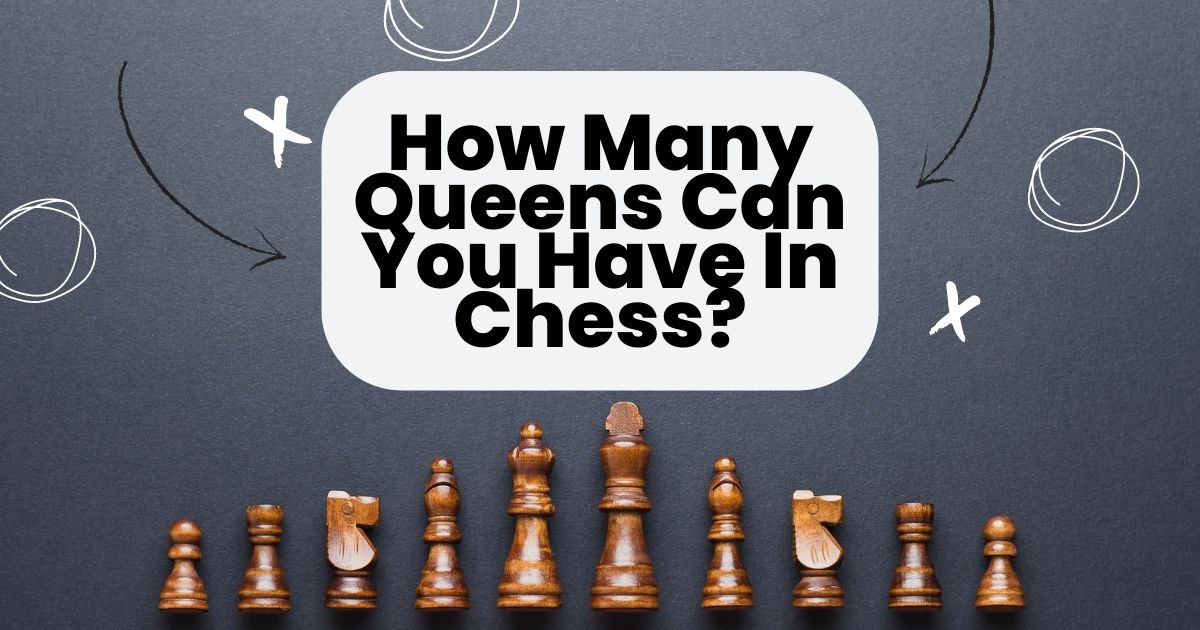Chess has recently seen a rather sudden and significant rise in popularity, mainly due to that “one show.” As such, questions like “how many queens can you have in chess” are quite normal nowadays – and that’s a very good thing!
This sport had seen little to no online media attention up until recently when, besides the show, several professional players entered the online stage of things. Driven there by the restrictions of the pandemic or not, it’s great to see that even the streaming platform Twitch.tv has a dedicated Chess category with over 2.2 million followers!
As chess is on the rise, it goes without saying that you have to learn how many queens you can have in chess. Believe it or not, this aspect is essential for a winning strategy!

How Does the Queen Move In Chess?
In chess, the queen has the greatest range of moves. This is why you must answer the “how many queens can you have in chess” question early on to fully use her mobility.
The queen can move diagonally, horizontally, and vertically for any number of squares as long as she doesn’t meet resistance. So essentially, the chess queen movement range is that of a bishop and rook combined.
How Many Queens Can You Have In Chess?
Theoretically, a player can have a total of nine queens in a game of chess. Players can achieve this through the game’s promotion rule (or feature, if you may). Promoting implies replacing a pawn that successfully reached the last rank of the chess board with one of the four piece types – knight, bishop, rook, and queen.
A player could have a total of ten rooks, ten knights, ten bishops, or nine queens. In almost all cases, a player will choose to promote a pawn to a queen, given the piece’s mobility. Promoting a different piece can be a viable choice, depending on the used strategy or employed tactics.
A List of Queen Moves in Chess
Where Does the Queen Go in Chess?
There are three essential (and famous) queen moves in chess and five support moves that have the role of assisting and protecting the queen. You must know them if you want to improve your strategy and also be able to switch tactics as you play!
Queen Move #1 – The Kiss of Death
The Kiss of Death is a guaranteed checkmate, at least in practice. It starts with the queen attacking the opposite king diagonally. For the tactic to succeed, your king must back the queen, thus protecting her from enemy pieces.
The result is a classic queen and king checkmate.
Queen Move #2 – Scholar’s Mate
The Scholar’s Mate, though often considered a beginner tactic, can be difficult to replicate. It implies pushing the opponent aggressively and can result in a checkmate in no more than four moves if done correctly.
The theory is simple and to the point – move the king pawn to 1.E4, transfer the bishop to C4, move the queen to H5, and finally capture the pawn sitting on F7. The enemy king is among ally pieces, unable to move, while your bishop protects your attacking queen, resulting in a clean checkmate.
Queen Move #3 – The Queen’s Gambit
The Queen’s Gambit, as the name implies, is one of the many gambit tactics in chess. It means sacrificing a piece to ensure board control or the checkmate. For this particular tactic, you will sacrifice a single pawn – the queen pawn – to gain control of the board’s center. You need only three moves to achieve the Queen’s Gambit.
The White player starts by moving the queen’s pawn two squares ahead. Then, the ideal scenario has the Black player replicating the move, moving the queen pawn two squares forward. The final action has the White player advancing the bishop on the queen’s side two squares ahead.
Players often use this tactic to study how the opponent plays, as they’ll have to spend the start of the game responding to them, creating threats for their side of the board.
Support Chess Queen Moves – How Can You Help the Queen During a Match?
There are five support tactics that you can rely on to help, support, or protect your queen during a match. All of them imply sacrificing, but you enjoy a better position on the board and advantages in terms of piece number.
The five tactics are the deflection sacrifice, the magnet sacrifice, the destruction sacrifice, the suicide sacrifice, and the clearance sacrifice:
- Deflection implies sacrificing a piece to distract the enemy’s attention from a certain square on the board (where the queen stands or might stand).
- Magnet implies sacrificing a piece to direct an enemy piece to a square that has no strategic advantages for you.
- Destruction implies sacrificing a piece to bring out an enemy piece that is inferior, and that your queen can directly attack. This tactic serves as a means to play your queen.
- Suicide implies sacrificing a piece capable of legal moves to create a stalemate, resulting in a draw and strategically avoiding defeat.
- Clearance implies sacrificing a piece standing on a square you intend to move the queen on.
The strategies and tactics mentioned above are relatively easy. With a lot of practice, they can become a part of your player’s persona!
Can a Queen Move Like a Knight?
The queen cannot move like a knight for several important reasons. First, the queen can only move in a straight line. As you probably know, the knight moves in the shape of the letter “L.” Second, the queen cannot jump over pieces, whereas the knight can do so freely.
A rather logical answer would be that the queen doesn’t have a swift horse like the knight.

The Two Types of Pawn Promotion
There are two types of pawn promotion in chess – Queening and Underpromotion. Queening implies promoting a pawn to a queen, while Underpromotion implies promoting a pawn to any other piece (knight, bishop, rook).
As mentioned earlier, the most logical choice in many situations and while employing most strategies is Queening. However, depending on the game’s course and enemy tactics, you might decide that you need a knight or a bishop. The choice is 100% situational!
Our Pawn Promotion Tips
Even though the choice is situational, there are a couple of things that can make it (the choice) perform better – namely, to your advantage. This boils down to knowing the rules and basically knowing what you can and cannot do!
Tip #1 – Finish the Journey With Your Pawn
A pawn can become a queen (or another type of piece) only after reaching the final square, which is known as promoting square. If you have the pawn on the square before the final square, pick up the queen, and place it on the final square (without effectively moving the pawn on the final square), you’ve just made an illegal move.
Tip #2 – State the Nature of the Promotion
Lack of attention can cause the arbiter or the enemy player to call out for an illegal move if they wake up with a different piece where a pawn should be. This is why it’s recommended to state the nature of the promotion you’re about to make – namely, “name” the type of piece intended for promotion out loud.
Tip #3 – Stop the Clock if You’re Not Able to Promote
In tournaments, the clock is both your best friend and fiercest enemy. For instance, it will definitely work against you if no pieces are available for promotion and you have to wait for one. If you do have to wait, then you can stop the clock. Then, call the arbiter and ask for a replacement piece so that you can finish the promotion.
Tip #4 – Watch Out for the Inverted Rook
A rook in an inverted position represents (and plays as) a queen. You just have to turn it upside down. Players often do this when an extra queen piece is unavailable for promotion or actual gameplay.
However, before inverting a rook and calling it queen, ensure that the tournament or event you’re in allows for this type of move. An inverted rook is still a rook, and, depending on the rules, an arbiter might consider it so even after you used a pawn to grab your inverted rook queen. This can have serious consequences later in the game.
Why Can You Have More Than One Queen in Chess?
The answer to this question lies within the very history of chess, stemming from one of its ancestors, the game of “chaturanga.” There, pawn promotion happens when the piece reaches the board’s last row, although it is unclear what promotion pieces are available.
According to some, a pawn is to become a mantri that can move only diagonally, only one square at a time. The mantri is an ancestor to today’s queen in chess. The idea behind this is to have the pawn (essentially, a foot soldier) promoted to the lowest officer rank when it reaches the end of the battlefield, behind the enemy lines.
Other sources state that the pawn can become only the piece initially located on the final square it lands on. If the pawn were to stand on the king’s square, it would become a mantri, this being an exception to the rule.
In short, you can have more than one queen in chess mainly because of the game of “chaturanga” created way back in the 6th century, which stands as the foundation for all similar games, including chess.
Even though great names in the history of chess, such as Philidor and Lambe, opposed the possibility of having multiple queens on the board, unrestricted promotion was popular enough to have Jacob Sarratt’s book give access to this type of move.
How To Get More Than One Queen
It is simple – have more than one pawn reach the end square of the board and choose a queen as your promotion piece two times. Remember that you can promote a pawn to a queen even if your queen is still in the game. In this case, you only need to promote a pawn to queen once, and voila! – you now have more than one queen.
In casual games, you can rely on the inverted rook tip mentioned above if you don’t have any more queen pieces available. Some players also represent a queen by laying down two pawns in the shape of the letter “X.”

Recap
Chess is easy to learn and difficult to master – you’ve probably heard this a thousand times! However, one rather unstressed part of the game’s experience is nailing down its rules, exceptions, and sometimes tricks. As such, the question “can you have two queens in chess?” is often found in the thoughts of beginners and experienced players alike!
Luckily, if you’re reading this sentence, you now know that a player can have up to nine queens in chess and that the process is, in theory, easy to complete. Naturally, in serious games, you might have two or, at best, three queens on the board.
Knowing how pawn promotion works and how to get a pawn on the final square is essential. After all, the queen’s mobility is pretty much unparalleled, and, as you’ve noticed in a previous paragraph, it can help you take down the opponent in only four moves!

